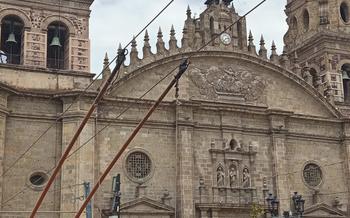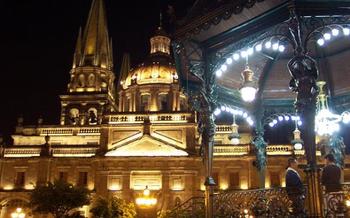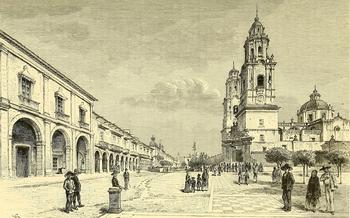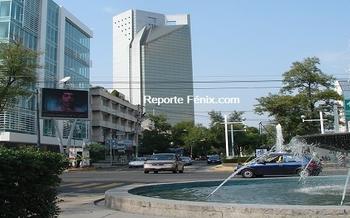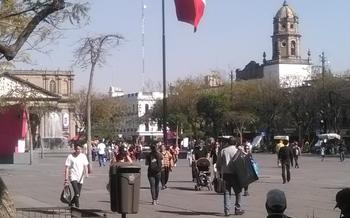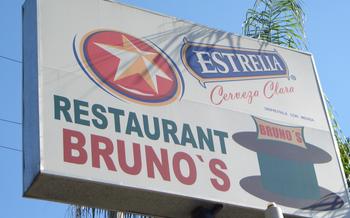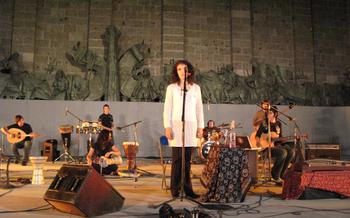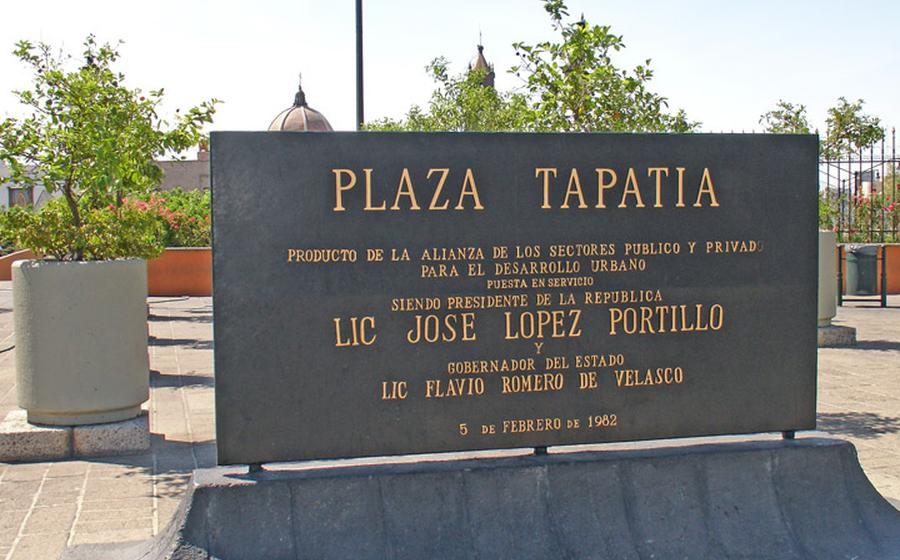
Plaza Tapatía
- Location and Accessibility, Architectural Features and Design
- The Legacy of Teatro Degollado
- Plaza de Toros Nuevo Progreso: A Bullfighting Venue
- Exploring Templo Expiatorio del Sagrado Corazón
- Indulge in Local Flavors at Mercado San Juan de Dios
- Parque Agua Azul: A Serene Oasis
- Strolling along Calle Pedro Moreno
- The Enchanting Rotunda de los Hombres Ilustres
- Plaza de los Mariachis: Music and Celebration
- Exploring the Guadalajara Cathedral: A Journey Through History and Faith
- Museo de las Artes (MUSA): Contemporary and Modern Art
- Insider Tip: Planning Your Visit
Location and Accessibility, Architectural Features and Design
Plaza Tapatía, a vibrant and historical square in Guadalajara, Mexico, is a must-visit destination for anyone seeking a rich cultural experience. Conveniently situated in the heart of the city, this expansive plaza offers easy access to Guadalajara's other attractions. Its central location makes it a popular starting point for exploring the city on foot.
The architectural design of Plaza Tapatía exudes grandeur and elegance. The square features a blend of architectural styles, showcasing the city's rich history. Cobblestone walkways, intricate fountains, and lush gardens create a charming and inviting atmosphere. The plaza is surrounded by iconic buildings, including the Palacio de Gobierno, the Teatro Degollado, and the Museo Regional, each contributing to its architectural significance.
The Legacy of Teatro Degollado
Teatro Degollado, situated majestically within Plaza Tapatía, stands as a testament to Guadalajara's rich cultural heritage and architectural splendor. Constructed between 1856 and 1866, this neoclassical masterpiece was the brainchild of architect Jacobo Gálvez and has since become an emblem of the city's cultural identity.
Its ornate façade, adorned with intricate carvings and sculptures, offers a glimpse into the grandiosity of the past. Step inside, and you'll be greeted by a breathtaking interior featuring a horseshoe-shaped auditorium, three tiers of balconies, and a magnificent ceiling mural by renowned Mexican artist Gerardo Murillo, also known as Dr. Atl.
Teatro Degollado has played a pivotal role in Guadalajara's cultural landscape, hosting a diverse array of performances, from opera and ballet to concerts and plays. The theater has witnessed countless memorable moments, including the premiere of Manuel M. Ponce's opera "La Hija del Rey" in 191
Today, the theater continues to be a vibrant center for the performing arts. It hosts a regular season of performances by the Guadalajara Symphony Orchestra, the Jalisco Philharmonic Orchestra, and the Guadalajara Ballet Company. It also serves as a venue for international touring companies and special events.
Beyond its cultural significance, Teatro Degollado holds a special place in the hearts of Tapatíos, the people of Guadalajara. It stands as a symbol of the city's pride and cultural achievements, a legacy that continues to inspire and captivate audiences to this day.
Plaza de Toros Nuevo Progreso: A Bullfighting Venue
Amidst the vibrant tapestry of Guadalajara's cultural heritage, the Plaza de Toros Nuevo Progreso stands as a testament to a controversial yet deeply ingrained tradition: bullfighting. Completed in 1967, this iconic bullring has become a symbol of Mexican identity and a focal point for debates surrounding the ethics and preservation of this ancient practice.
With a seating capacity of over 16,000 spectators, the Plaza de Toros Nuevo Progreso has witnessed countless bullfights, showcasing the bravery of matadors and the agility of fighting bulls. The atmosphere during these events is electric, with the crowd roaring in anticipation and awe as the drama unfolds in the ring.
Beyond bullfights, the Plaza de Toros Nuevo Progreso has also hosted numerous concerts, sporting events, and cultural spectacles. Its versatility has made it a beloved venue for a wide range of entertainment, attracting both locals and tourists alike.
In recent years, bullfighting has faced growing criticism from animal rights activists, who argue that it is a cruel and barbaric practice. As a result, the future of bullfighting in Mexico remains uncertain. However, the Plaza de Toros Nuevo Progreso continues to stand as a symbol of this controversial tradition, a reminder of Mexico's complex cultural identity.
Exploring Templo Expiatorio del Sagrado Corazón
In the heart of Plaza Tapatía stands the Templo Expiatorio del Sagrado Corazón, a magnificent75 years, reflecting the dedication and artistry of its builders. The cathedral is a testament to the city's rich religious heritage and serves as a spiritual sanctuary for both locals and visitors.
Beyond its architectural grandeur, the Templo Expiatorio holds deep symbolic and religious significance. It is dedicated to the Sacred Heart of Jesus, a symbol of divine love and compassion, and its design incorporates numerous religious motifs and iconography. The intricate stained glass windows depict scenes from the life of Christ and the saints, casting a kaleidoscope of colors that illuminate the cathedral's interior. The vaulted ceilings, adorned with intricate carvings and frescoes, further enhance the sacred atmosphere, creating a space of profound contemplation and reverence.
Indulge in Local Flavors at Mercado San Juan de Dios
For a true taste of Guadalajara's culinary heritage, head to Mercado San Juan de Dios, a bustling market that has been a beloved local institution for over a century. Immerse yourself in the vibrant atmosphere as you wander through the maze-like corridors, where vendors proudly display their wares, from fresh produce and meats to traditional Mexican specialties.
Indulge in the tantalizing aromas of freshly made tortillas, mouthwatering tamales, and succulent barbacoa, a slow-cooked meat dish that is a regional delicacy. Sample the local cheeses, including the renowned queso fresco, and savor the flavors of exotic tropical fruits that you may not find elsewhere.
At Mercado San Juan de Dios, you can satisfy your sweet tooth with traditional Mexican desserts like churros, flan, and cajeta, a caramel sauce made from goat's milk. Don't miss the opportunity to try birria, a traditional stew made with goat meat or beef, served with a flavorful consommé and tortillas.
Beyond its culinary delights, the market is also a vibrant cultural hub. Engage with the friendly locals, learn about their traditions, and witness the daily life of this vibrant city. Take your time to explore the market's hidden corners and discover unique ingredients and flavors that will leave a lasting impression.
Parque Agua Azul: A Serene Oasis
Amidst the vibrant streets and bustling plazas of Guadalajara, Parque Agua Azul offers a tranquil retreat for weary travelers and locals alike. This urban oasis, located just a short walk from the Plaza Tapatía, invites visitors to immerse themselves in serenity and contemplation.
Established in 1989, the park is a testament to the city's commitment to preserving green spaces and creating harmonious environments. Its lush gardens, meticulously landscaped with a variety of trees, flowers, and shrubs, provide a feast for the eyes and a respite from the urban hustle and bustle.
At the heart of the park lies a series of cascading fountains, their gentle flow creating a soothing melody that echoes through the air. The fountains, adorned with intricate tilework and sculptures, add a touch of elegance and whimsy to the serene surroundings.
Parque Agua Azul is not just a place for passive relaxation but also a vibrant cultural hub. Throughout the year, the park hosts a variety of events, including concerts, art exhibitions, and traditional Mexican festivals. These events bring together the community and offer visitors a glimpse into the rich cultural heritage of Guadalajara.
Strolling along Calle Pedro Moreno
Amidst the vibrant tapestry of Guadalajara, Calle Pedro Moreno stands as a testament to the city's rich history and architectural charm. This iconic pedestrian street, named after a renowned Mexican patriot, beckons visitors with its old-world ambiance and a treasure trove of cultural landmarks.
As you embark on a leisurely stroll along Calle Pedro Moreno, the ornate facades of colonial-era buildings will transport you back in time. Admire the intricate carvings, colorful tiles, and grand balconies that adorn these architectural masterpieces. Many of these buildings now house charming cafes, art galleries, and boutique shops, inviting you to explore and discover hidden gems.
Calle Pedro Moreno is also home to several cultural landmarks that offer a glimpse into Guadalajara's storied past. Visit the Museo Regional de Guadalajara, housed in a former monastery, to learn about the region's pre-Hispanic and colonial heritage through fascinating exhibits and artifacts.
Strolling along Calle Pedro Moreno is a sensory experience that will delight and captivate. The air is filled with the aromas of freshly brewed coffee and traditional Mexican cuisine wafting from nearby restaurants. Street vendors display their colorful wares, offering a vibrant array of handicrafts and souvenirs.
As you continue your walk, you'll encounter the Plaza de la Liberación, a bustling square that serves as a gathering place for locals and visitors alike. Take a moment to relax on a bench, soak in the lively atmosphere, and watch the world go by.
Calle Pedro Moreno is a must-visit destination for anyone seeking a taste of Guadalajara's authentic charm and cultural heritage. Whether you're shopping for unique souvenirs, admiring architectural wonders, or simply immersing yourself in the city's vibrant energy, this historic street promises an unforgettable experience.
The Enchanting Rotunda de los Hombres Ilustres
Amidst the vibrant energy of Plaza Tapatía stands the enchanting Rotunda de los Hombres Ilustres, a testament to the city's rich history and cultural legacy. This iconic rotunda is a poignant tribute to the distinguished figures who have shaped Guadalajara's identity and contributed to its cultural tapestry.
The rotunda's ornate architecture, with its graceful columns and intricate carvings, provides a fitting backdrop for the bronze statues that grace its interior. Each statue immortalizes a notable personality from Guadalajara's past, from renowned artists and intellectuals to political leaders and philanthropists.
Here, visitors can pay homage to the likes of José Clemente Orozco, whose powerful murals have left an indelible mark on the city's artistic landscape. The legacy of Mariano Otero, a prominent liberal thinker and statesman, is also celebrated within these walls.
The Rotunda de los Hombres Ilustres serves as a profound reminder of the indomitable spirit and unwavering dedication of those who have tirelessly worked to elevate Guadalajara's cultural stature. It is a place where history and heritage converge, inviting visitors to delve into the lives and accomplishments of the city's most illustrious sons.
Plaza de los Mariachis: Music and Celebration
Amidst the vibrant heart of Guadalajara, where history intertwines with enchanting melodies, lies the Plaza de los Mariachis. This iconic square is a living testament to the city's deep-rooted musical traditions and a must-visit destination for any traveler seeking an authentic Mexican experience. As you step into the plaza, the air fills with the lively rhythms of mariachi bands, serenading visitors with their soulful renditions of traditional songs.
The history of mariachi music is deeply intertwined with the cultural heritage of Guadalajara. It is believed to have originated in the 19th century, when small ensembles of musicians would gather in public spaces to play for celebrations and festivals. Over the years, mariachi music evolved into a beloved genre, gaining popularity both in Mexico and beyond.
Today, the Plaza de los Mariachis stands as a living tribute to this cherished musical tradition. As you stroll through the plaza, you'll find numerous mariachi bands dressed in their traditional attire, ready to serenade you with their enchanting melodies. Whether you're celebrating a special occasion or simply seeking a memorable experience, hiring a mariachi band is an unforgettable way to immerse yourself in the vibrant culture of Guadalajara.
In addition to its musical offerings, the Plaza de los Mariachis is also a hub of activity and entertainment. Surrounding the square, you'll find a variety of restaurants, bars, and shops, offering a delightful array of culinary delights and local crafts. As the sun sets, the plaza transforms into a lively nightlife destination, where locals and visitors alike gather to enjoy the music, dance, and celebrate the infectious energy of Guadalajara.
So, if you find yourself wandering through the streets of Guadalajara, be sure to make your way to the Plaza de los Mariachis. Let the enchanting melodies of mariachi bands transport you to a world of musical magic, where history, culture, and celebration intertwine. Embrace the vibrant spirit of this iconic square, and experience the true essence of Guadalajara's musical heritage.
Exploring the Guadalajara Cathedral: A Journey Through History and Faith
At the heart of the vibrant city of Guadalajara, nestled amidst bustling streets and towering skyscrapers, stands the majestic Guadalajara Cathedral, a testament to the city's rich history and enduring faith. This stunning edifice, a symbol of Guadalajara's cultural heritage, invites travelers to embark on a journey through time, exploring its architectural grandeur, religious significance, and the captivating stories that unfold within its sacred walls.
The cathedral's imposing facade, adorned with intricate carvings and delicate tracery, hints at the artistic treasures that lie within. Step inside, and you'll be greeted by a breathtaking spectacle of stained-glass windows, casting a kaleidoscope of colors onto the marble floors below. Each window tells a biblical tale, narrating the life of Christ and the saints with vibrant hues and exquisite detail.
Built in the 16th century, the Guadalajara Cathedral has witnessed countless historical events, from the city's humble beginnings to its rise as a thriving metropolis. Its walls reverberate with the echoes of centuries past, whispered in the prayers of countless believers who have sought solace and inspiration within its hallowed halls.
Beyond its religious significance, the cathedral is a masterpiece of architectural prowess. Its fusion of Gothic and Baroque styles creates a harmonious blend of grandeur and elegance. Intricate carvings adorn the walls, depicting scenes from the Bible and the lives of saints, while the soaring vaults and graceful arches evoke a sense of awe and wonder.
As you wander through the cathedral's vast interior, take a moment to pause and admire the intricate altarpieces, each a testament to the skill and devotion of master craftsmen. The main altarpiece, a masterpiece of Baroque exuberance, is adorned with gold leaf, intricate carvings, and life-size sculptures that seem to come alive before your eyes.
The Guadalajara Cathedral is not merely a historic monument; it is a living, breathing testament to the enduring power of faith. Throughout the year, the cathedral hosts a variety of religious services, concerts, and cultural events, drawing both locals and visitors alike. Whether you're seeking spiritual fulfillment or simply marveling at its architectural beauty, the Guadalajara Cathedral promises an unforgettable experience that will leave a lasting impression on your soul.
Museo de las Artes (MUSA): Contemporary and Modern Art
A Sanctuary for Artistic Expression
Plaza Tapatía proudly houses the Museo de las Artes (MUSA), a contemporary and modern art museum that serves as a vibrant hub for artistic expression and innovation. Inaugurated in 1994, MUSA is a haven for art enthusiasts, showcasing an extensive collection of Mexican and international works that span various artistic movements and genres.
Step into the museum's captivating galleries and immerse yourself in a world of creativity. Explore thought-provoking exhibitions that showcase the works of renowned Mexican artists, such as José Clemente Orozco, Diego Rivera, and Frida Kahlo, alongside international masters like Pablo Picasso, Salvador Dalí, and Andy Warhol.
MUSA's diverse collection encompasses a range of mediums, including paintings, sculptures, installations, photography, and multimedia art. Admire the vibrant colors and bold brushstrokes of abstract expressionism, contemplate the poignant narratives of surrealism, and delve into the depths of conceptual art.
The museum's dynamic exhibitions are complemented by a calendar of cultural events, workshops, and educational programs that foster artistic appreciation and engagement. Participate in guided tours led by knowledgeable curators, attend artist talks and panel discussions, or simply soak in the creative atmosphere as you wander through the galleries.
Whether you're an art aficionado or simply seeking a stimulating and thought-provoking experience, MUSA offers an unparalleled journey into the world of contemporary and modern art. Its collection and exhibitions provide a unique lens through which to understand the complexities of our ever-evolving cultural landscape.
Insider Tip: Planning Your Visit
To fully immerse yourself in the vibrant essence of Plaza Tapatía, plan your visit during the city's renowned Fiestas de Octubre, held annually in October. This month-long celebration transforms the plaza into a lively hub of music, dance, and cultural events, showcasing the rich traditions and heritage of Guadalajara.
When interacting with locals, remember to greet them with a warm "Hola" and maintain eye contact as a sign of respect. While the plaza is generally safe, it's advisable to remain cautious and avoid carrying large sums of cash or wearing flashy jewelry.
Indulge in the delectable local cuisine at nearby restaurants, such as La Chata or Karne Garibaldi, renowned for their authentic Mexican dishes. For a unique coffee experience, visit Café San Agustín, housed within a historic building with a charming ambiance.
Explore the surrounding attractions, including the Instituto Cultural Cabañas, a UNESCO World Heritage Site adorned with stunning murals by José Clemente Orozco, and the Templo Expiatorio del Sagrado Corazón, a majestic neo-Gothic cathedral.
Embrace the vibrant spirit of Plaza Tapatía, where history, culture, and entertainment converge to create an unforgettable experience.
